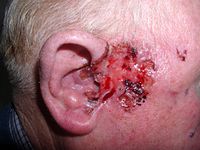
Photo from wikipedia
Basal cell carcinoma is the most commonly occurring cancer worldwide but it is rarely seen in non-sun-exposed areas of the body such as the scrotum.1 Basal cell carcinomas account for… Click to show full abstract
Basal cell carcinoma is the most commonly occurring cancer worldwide but it is rarely seen in non-sun-exposed areas of the body such as the scrotum.1 Basal cell carcinomas account for 5–10% of all scrotal tumours.2,3 Scrotal basal cell carcinoma is considered more aggressive with higher rates of metastasis versus non-scrotal basal cell carcinoma.1 Gorlin syndrome or nevoid basal cell carcinoma syndrome is an autosomal dominant condition characterised by the development of multiple basal cell carcinomas at a young age.4,5 Prevalence of nevoid basal cell carcinoma syndrome is reported to range from 1 in 57,000 to 1 in 164,000.5 We present the case of a 58-year-old gentleman with a 3-month history of bleeding scrotal and penile lesions. These lesions were excised with 2 cm margins and without complication. Histology showed surface ulceration with basaloid infiltrating tumour extending into the dermis. Given the potential for a very high rate of tumour occurrence within individuals, surgical management of basal cell carcinomas can result in significant, lifestyle-limiting disfigurement.5 As understanding of the pathogenesis of nevoid basal cell carcinoma syndrome has advanced, a number of targeted therapies have been developed.5 Vismodegib targets the Hedgehog signalling pathway and is used in the treatment of locally advanced and metastatic basal cell carcinomas. This represents a rare case of basal cell carcinoma of the scrotum associated with nevoid basal cell carcinoma syndrome caused by a de novo mutation. It is not clear from the literature whether incidence of scrotal tumours is increased in Gorlin syndrome but given the increased risk of basal cell carcinoma elsewhere, it may be prudent for those with known Gorlin syndrome to regularly examine the scrotal skin along with recommended frequent dermatologic surveillance. Level of evidence: 5.
Journal Title: Journal of Clinical Urology
Year Published: 2019
Link to full text (if available)
Share on Social Media: Sign Up to like & get
recommendations!